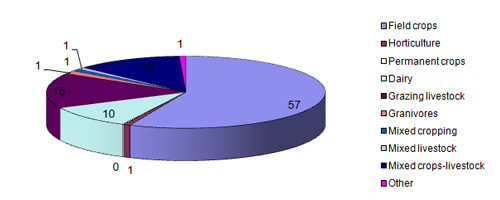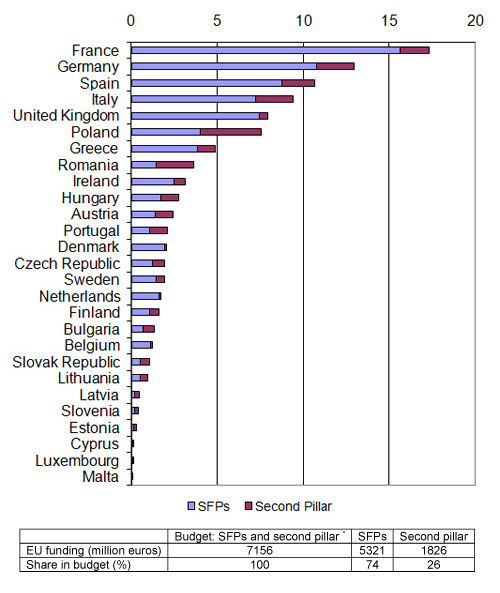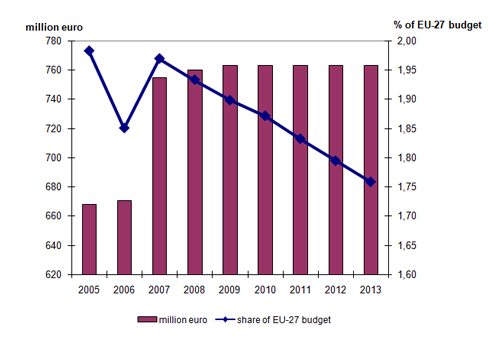Sweden
• General country description
• A. First pillar: implementation of CAP reforms (2003)
• B. Second pillar: implementation of RDP measures during 2007-2013
• C. Vision for the CAP beyond 2013: a short overview of the debate (at Member State level) on future CAP reform
• D. Literature, sources, references
• The comparative analysis provides a compact overview of CAP implementation across all 27 Member States and their visions of the future of the CAP
General country discription
Sweden |
Comparison with EU-25 |
Population, 2005 (*1,000,000): 9.0 |
2.0% of population in EU-25 |
Population density, 2003 (inh./km2): 22 |
118 in EU-25 |
GDP/capita, 2005 (PPS): 27,700 |
118% of GDP/capita in EU-25 |
Share agriculture in total employment, 2002 (%): 1.8 |
5% in EU-25 |
Share Utilized Agricultural Area in total land area, 2003 (%): 8 |
46% in EU-25 in 1998 |
Average farm size, 2005 (ha): 42 |
19 in EU-15 |
Number of farms, 2005 (*1000): 75,8 (over 2 ha) |
1.0% of farms in EU-25 |
Source: own calculations based on Eurostat
Distribution of farming types, 2005 (% of total)

Source: own calculations based on Eurostat
EU funding for the Single Payment Scheme (SPS)
and the second pillar, 2007-2013

Funding according to CAP budget including Bulgaria and Romania.
Sources: Agra Europe (2007); CEU (2006); EC (2007a)
A. First pillar: implementation CAP reform (2003)
A.1 Single Payment Scheme
Model
SPS static hybrid moving (EC, 2007b)
Coupling measures
Complete decoupling, except for special male bovine premium (75% coupled). Article 69 application ( 0.45% of the total ceiling), dairy premium in 2005.
Reason for selection
Partly coupling in order to maintain certain types of production.
A.2 EU budget for Single Payment Scheme (SPS) per year (National ceiling) 2005-2013

Source: 2005: EC (2006); 2006-2013: CEU (2006) and Agra Europe (2007)
Share of the farms that receive SPS of the total number of farms (% of total)
83 000 farms received SPs that is 109% of the farms as some units - below 2 ha - are not considered farms, but meet the requirements to receive SPs.
Tradability of SPS
Single payments are tradable within regions.
A.3 Cross-compliance: Good Agricultural and Environmental Conditions (GAEC)
(Source: IEEP, 2005;)
Selected standards of the GAEC
Issue |
Standards |
Comment (IEEP) |
soil erosion |
Minimum soil cover |
Any land taken out of production or set aside must maintain a green cover |
protection of permanent pastures |
|
prevent a drop of more than 10% compared to 2003. Authorization required to convert pp |
minimum level of maintenance |
minimum livestock stocking rates or/and appropriate regimes |
at least 1 LU/ha once a year on permanent pasture. PP is characterized by tree growth and often on rocky and wet ground with high biodiversity value. |
|
avoiding the encroachment of unwanted vegetation on agricultural land |
|
|
EXTRA: agricultural land no longer in use |
comparable to measures that apply to all set-aside land: maintain green cover. Specific guidelines available. |
|
EXTRA: environmental conditions |
restriction on levels used of fertilizer and manure in defined periods of the year |
Sweden emphasis on the minimum level of maintenance.
Reason for selection of cross compliance standards
It was recognised that the requirements do not adequately reflect the priority environmental problems. For example, the soil erosion issues raised by Annex IV are not an especially large problem in Sweden. Nevertheless, the Swedish Board of Agriculture asked the EC whether the issues and standards in Annex IV should be seen as a set of minimum rules that must be covered by Swedish cross compliance. The Swedish Board had the impression that the European Commission agreed that Annex IV could be read as an example list. Concurrently, the agriculture ministry concluded that the rules for cross compliance should not be dissimilar to current demands, especially those already in place for set-aside, and that permanent pasture should always be maintained by grazing animals.
A.4 Further reform of market regulations
Wine
The present structural crisis in the European Union wine sector and the chronic market imbalance show that the common market organisation (CMO) for wine must be fundamentally reformed. Decreasing demand for European wine due to changed consumer preferences, health consciousness and more competition from third countries have resulted in increasing wine stocks. The surplus is transferred to distillation and used as bio-ethanol for fuel and industrial uses at a considerable cost to the public economy.
Simplification of complex rules of the current CMO is necessary. The rules for European winemaking methods need to be reviewed in order to make them more flexible and competitive. The present quota system and the planting restrictions must be removed leading to an overall reduction of budget expenditure. Improved competitive conditions can only be achieved by an increased market orientation In the long run the CMO should be abolished.
The Swedish proposal for a reform in the wine sector can be summarised as follows:
- The measures for market regulation, such as distillation (all kinds) and export refunds (in compliance with the new WTO agreement) have to be removed from the CMO,
- Abolish the system of planting rights,
- Increase permanent abandonment and abolish the system of restructuring and conversion of vineyards,
- Simplify the rules, especially those about oenological practices and processes, records and labelling of wines.
This proposal leads to an overall reduction of budget expenditures, and an increased margin to the Brussels ceiling. This could contribute to delaying the need for the mechanism for financial discipline and thus avoid an increased administrative burden and uncertainty in allocation of direct payments.
Fruit and vegetables
Swedish position well known. Decision made in Agricultural Council meeting in June 2007. Complete decoupling of processing of fruit and vegetables within 4 years for tomatoes and within 5 years for permanent crops (citrus). Role of producer organisation strengthened, especially in crisis prevention and -management.
Decoupling of other products, like tobacco, hop etc.
The long term objective is a fully market oriented production without subsidies. Elimination of the constraints on production is an important step to improve EU competitiveness as well as to achieve simplification. All remaining production aid, production quotas as well as processing aid schemes, within the CMO for (tobacco), cotton, fibre plants, dried fodder, potato starch should be phased out in order to achieve 100% decoupling. In this process the budgetary perspective is of significant importance and the opportunity of substantial budget cuts should be exploited.
Simplification into one market regulation
Swedish position well known. Decision made in Agricultural Council meeting in June.
B. Second pillar: implementation of RDP measures 2007-2013
B.1 Programme level and approval
There is one national RDP. The Rural Development Committee (consisting of representatives of the 27 Member States) has approved the RDP for Sweden on 23 May 2007.
B.2 Distribution of public budget over the axes (%)1)
axis 1: competitiveness |
axis 2: environment and land management |
axis 3: rural economy |
Axis 4: Leader |
14 |
70 |
8 |
7 |
1) Figures excluding Technical Assistance
Source: Own calculations based on Jordbruksdepartementet (2007)
B.3 Integration of Leader in axes 1, 2 and 3
Leader contributes to Axes 1 and 2 and especially to Axis 3. In addition, co-funding on a local level and the bottom-up approach are seen as strengths of Leader.
B.4 Local Action Groups (LAGs)
It is intended to reach about 50% of the rural population at the end of 2007 and about 75% at the end of 2008. In 2000-2006 there were 12 areas / LAGs, serving about 485,000 people, which is about 20% of the rural population (2004). The planned indicative number of LAGs for the period 2007-2013 is 60.
B.5 RDP budget 2007-2013 (million euros)
total public budget |
% co-financing EAFRD1) |
EAFRD budget |
Contribution private sector |
Total costs |
National top-ups |
3917.2 |
47 |
1825.6 |
1510.4 |
5427.6 |
0 |
1) % of co-financing may vary per axis
Source: Jordbruksdepartementet (2007)
B.6 Less Favoured Areas
In 2005 1,600,000 ha was designed as Less Favoured Areas (LFA) (44% of UAA) (CEU, 2005).
B.7 Drivers of RDP strategy
Fit within national policy.
National initiatives are not named specifically in the RDP, but there are relations with the Swedish national environmental goals* and the national policies on tourism, lapp culture/nature, training, renewable energy and broadband development.
* Information provided by Gun Rudquist, Swedish Society for Nature Conservation.
C. Vision on the CAP beyond 2013*
C.1 Stages in the development of the CAP debate
Is there a debate about the CAP beyond 2013?
Yes, there is a debate, in which the 'non-paper' on Swedish views on the future of the CAP and the Health Check (Swedish Ministry of Agriculture et al., 2007) acts as a kind of catalyst. A working group is involved in this debate, composed by delegates from the Ministry of Agriculture, the Swedish Board of Agriculture and the Swedish Institute for Food and Agricultural Economics, a reference-group composed by farmers' organizations and NGOs and a contact group from the Parliament Committee of Environment and Agriculture.
C. 2 Key issues in the debate
Components and role of the CAP (Swedish Ministry of Agriculture et al., 2007)
- Future reforms of the CAP should be guided by market orientation, consumer demand, deregulation and reduction of budget expenditure. The long-term goal is a fully market-oriented and sustainable agricultural production;
- Elimination of export subsidies and phasing out of market price support;
- Abolishment of all remaining production constraints (set aside, sugar quota and a phase out plan for dairy quotas);
- Full decoupling of agricultural support by 2013;
- Supplying public goods, such as biodiversity, open landscapes, wetlands and stone fences will remain an important objective of the EU and its member states;
- The modulation instrument is complicated, non-transparent and blunt and needs to be improved. The distribution criteria should be revised taking into account whole rural areas and the rural population, not only the agricultural sector;
- No establishment of an upper limit for support to holdings ('capping').This would only lead to the splitting up of holdings, thereby threatening the structural development of the sector.
Organization of the CAP (1st and 2nd pillar)
- Sweden has not yet taken any official position with regard to the future pillar structure;
- Simplifying the system of payment entitlements and the cross compliance rules.
Financing of the CAP (Agra Europe, 2007)
- Sweden generally advocates a reduction of budget expenditure;
- Whether agricultural support should be financed at EU level or national level needs to be carefully analyzed on the basis of the principles of subsidiarity, proportionality and sound financial management. This analysis should take place in the framework of the broader budget review scheduled for 2008/2009.
* IInformation provided by Gun Rudquist, Swedish Society for Nature Conservation and by Helena Vängby and Camilla Lehorst, Swedish Ministry of Agriculture, Food and Consumer Affairs.
D. Literature, sources, references
- Agra Europe (2007), "Threat of SFP cuts rises as NMS accede", Agra Europe Weekly, January 12
- Council of the European Union (CEU) (2005), Proposal for a Council Regulation on support for rural development by the European Agricultural Fund for Rural Development (EAFRD) - redefinition of intermediate less-favoured areas, Brussels, Working Party on Agricultural Structures and Rural Development, working document (7971/05), 15 April
- Council of the European Union (CEU) (2006), Council Regulation 1782/2003 (consolidated version - August 5, 2006), Annex VIII and VIIIa, Brussels
- European Commission (EC) (2006), 35th Financial Report on the European Agricultural Guidance and Guarantee Fund, Guarantee section, 2005 Financial Year, SEC(2006)1152
- European Commission (EC) (2007a), EU support for rural development 2007-2013; Pre-allocated funding under Heading 2 "Natural Resources" of the Financial Framework, Brussels: European Commission
- European Commission (EC) (2007b), Overview of the implementation of direct payments under the CAP in Member States Version February 2007, EC, DG for Agriculture and Rural Development
- IEEP (2005), The development and implementation of cross compliance in the EU15: an analysis. Report for the RSPB, Institute for European Environmental Policy
- Jordbruksdepartementet (2007), Landsbygdsprogram för Sverige år 2007 - 2013, Stockholm: Regeringskansliet, version 16 May 2007
- Swedish Ministry of Agriculture, the Swedish Board of Agriculture and the Swedish Institute for Food and Agricultural Economics (2007), Swedish views on the Common Agricultural Policy and the health check review; Non-paper, May 2007
